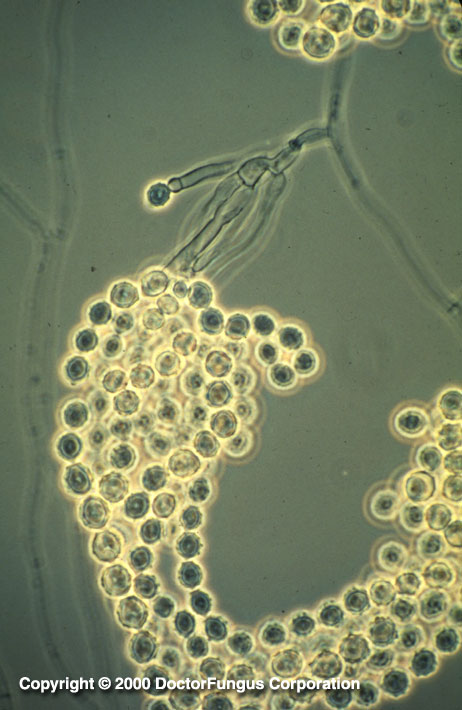(Saccardo) Bainer (1907)
Macroscopic morphology
Colonies on potato dextrose agar at 25°C grow rapidly, reaching 4.5 – 5.5 cm in 1 week. Colonies are initially white, becoming buff and powdery to granular at maturity. Reverse is honey-colored to brownish.
Microscopic morphology
Hyphae are septate and hyaline. Conidiophores terminate in groups of 2 to 4 annellophores in a scopula (broomlike structure, similar to a penicillus in the genus Penicillium) [2202]. Annellated zones on the annellides measure approximate 2.5 — 3.5 µm wide. Annelloconidia are globose to ovoid, measure 5-9 x 5-7 µm, have a distinctly truncate base, and are finely to coarsely roughened at maturity. The teleomorph is Microascus brevicaulis. Ascomata are black, spherical, and ostiolate with short necks measuring 80-150 x 70-130 µm. Ascospores are kidney-shaped, 5-6 x 3.5-4.5 µm, smooth, and reddish-brown in mass [de Hoog, Guarro et al. 2000], [1584].
Special notes
Scopulariopsis brevicaulis is an agent of onychomycosis [479], [531], [2248], and of opportunistic disease in immunocompromised patients [62], [66]. It has also been reported as the etiologic agent in a plantar infection [841], and in granulomatous skin disease [329]. Invasive manifestations include two cases of endocarditis associated with prosthetic valves [823], [1534], fungal keratitis [1372], [560], and posttraumatic fungal endophthalmitis [809].
FTL* in vitro susceptibility data
| AMB | CAS | ITRA | VORI | FLU | KETO | TERB |
|---|---|---|---|---|---|---|
| 8 µg/ml=1 | 4 µg/ml=1 | >8 µg/ml=1 | 4 µg/ml=1 | >64 µg/ml=1 | 16 µg/ml=2 | 0.5 µg/ml=1 |
| >16 µg/ml=2 | 8 µg/ml=1 | 8 µg/ml=2 |
| Drug/N | AMB/3 | CAS/2 | ITRA/1 | VORI/3 | FLU/1 | KETO/1 | TERB/1 |
|---|---|---|---|---|---|---|---|
| MIC Range | 8->16 | 4-8 | >8 | 4->8 | >16 | 2 | 0.5 |
* Fungus Testing Laboratory unpublished data (NCCLS M38-A)

